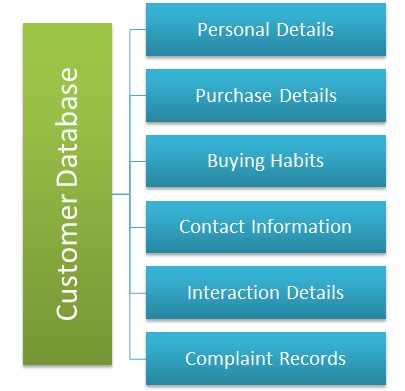Customer Database - Definition, Importance & Example
What is Customer Database?
Firms maintain a record of all their present and potential customers using customer database. The customer database stores information like personal details, buying habits, last interaction with the firm, contact information etc. Such databases help the firms to understand the customers buying pattern which is used to design products and decide on prices. The companies use the available list of potential customers to generate higher sales. Also, such a customer database makes it possible for the firm to provide personalized service to the customers.
A customer database is an organized collection of customer data which is used to analyze and create the appropriate marketing plan for a product or service. Current or past data gathered in the customer database from different sources like electronic transactions and web activity is stored in structured form in databases which aid in efficient decision making.
Importance of Customer Database
With more emphasis towards the use of statistical techniques, methodologies, and applications to develop models of customer behavior, attitudinal data, business patterns, future forecasts, and decision making marketers tend to be heavy users of customer Databases. Business Intelligence tools help to enhance business operations with interactive access and manipulation of data. A customer database, which is an internal database, is usually preferred than a data warehouse for marketing purposes as a data warehouse can contain a large pool of unstructured information which is irrelevant for marketing purpose and requires additional business intelligence tools for analysis. Database marketing helps target the right customers at the right time.
However, a customer database carries only the relevant information in a structured format which can be retrieved or analyzed using simple queries or minimal business intelligence tools.

Read More
Advantages of Customer Database
Some advantages of customer database in marketing are:
1. Analysis: Customer Database allows users to analyze data using tools like Microsoft Excel, Power Pivot and Power View which can make analysis and interpretation more efficient.
2. Simplicity: Data is stored in structured form in a database which makes it faster and more convenient to retrieve and analyze data through simple queries.
3. Data Security and Privacy: Users' identity is authenticated and only authorized users can access the data which conforms to the security feature of the database. There are also levels where users can view only that data which they have been allowed to maintaining the privacy of the data.
4. Access to Real Time Information: With the help of business intelligence tools, real-time data can be stored without delays to ensure effective decision making.
Disadvantages of Customer Database
Some drawbacks of customer database in marketing are:
1. High Investment: Setting up a database management system with proper business intelligence tools requires substantial hardware and software costs and need time and resources to install and design. The initial conversion cost from the file system to a database system is also high.
2. Training and execution: Firms need proper technical skills to design, install, support and maintain databases and the business intelligence tools. If adequate training is not given, it leads the database management systems and tools to run slowly, deliver uncertain results and break down frequently. Along with it, users need to be trained to understand the system and work efficiently with it.
Difference Between Customer Database and Data Warehouse
Both Customer Databases and data warehouses work on relational data systems whereas a data warehouse is built to store large quantities of unstructured, complex historical data, a database keeps only current, structured data and uses Online Transaction Processing (OLTP) for fast access to specific transactions. Data warehouses can analyze complex queries across all data with great efficiency using Online Analytical Processing (OLAP). While a customer Database contains data only related to customers and other required data for the marketing department only, a data warehouse stores enterprise-wide data, not just limited to any one department. Customer Databases are mostly used for transactional purposes. Though analytical queries can also be performed, they are difficult to carry out due to data complexity whereas, data warehouses make analytical queries simpler to perform.
Examples of Customer Database
1. Oracle RDBMS: Companies like WalMart, Amazon, Costco and Target use Oracle RDBMS which supports multiple UNIX and Linux and Windows versions. It supports large databases, reduces processing time and occupies less space.
2. SAP Sybase ASE: This is a relational model database server product designed to meet new demands for performance, reliability, and efficiency. It has been in use in different sectors like financial services, healthcare, transportation, telecommunication, and retail industry. With the help of cloud computing and synchronization of mobile devices with the software, it can perform millions of transactions swiftly.
Hence, this concludes the definition of Customer Database along with its overview.
This article has been researched & authored by the Business Concepts Team. It has been reviewed & published by the MBA Skool Team. The content on MBA Skool has been created for educational & academic purpose only.
Browse the definition and meaning of more similar terms. The Management Dictionary covers over 1800 business concepts from 5 categories.
Continue Reading:
What is MBA Skool?About Us
MBA Skool is a Knowledge Resource for Management Students, Aspirants & Professionals.
Business Courses
Quizzes & Skills
Quizzes test your expertise in business and Skill tests evaluate your management traits
Related Content
All Business Sections
Write for Us